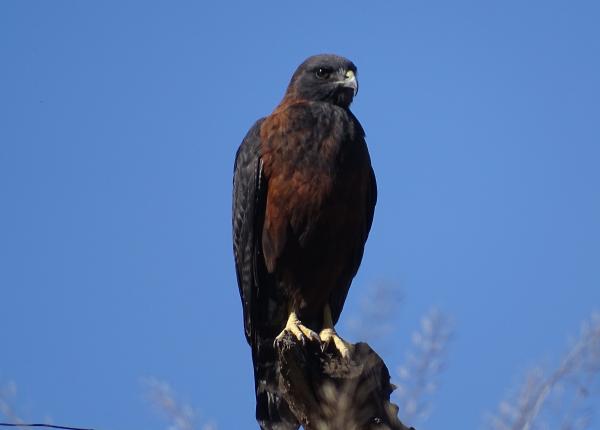Did You Know?
- Of all the hawks in the world, the Variable Hawk has the greatest variety of plumage patterns and colors.
- There are two recognized subspecies of Variable Hawk
How The Peregrine Fund is Helping
Though The Peregrine Fund does not work directly with Variable Hawks, our efforts in scientific research, habitat conservation, education, and community development help conserve birds of prey around the world. We also supply literature to researchers from our avian research library, which helps scientists around the world gather and share important information on raptor conservation. Our work with the Neotropical Raptor Network helps conserve raptors by fostering collaboration and communication among raptor enthusiasts in the region. And, finally, our support of the Global Raptor Information Network gives raptor researchers tools to more efficiently conduct their own studies while contributing to a global program. It also provides citizen scientists a way to participate in raptor science and conservation.
Where They Live
Variable Hawks are a Neotropical species found in western South America from Colombia to the southern tip of Chile and Argentina. It lives in a variety of habitats from semi-open areas, steep ridges, rugged mountains, montane grasslands, and Polylepis woodland, coastal lowlands, dry open country with scattered trees or shrubs, grasslands, or even agricultural lands.
What They Do
This diurnal raptor spends a lot of time soaring high above mountain ridges and valleys. When not soaring, it can be seen perching on rock ledges or on the ground.
The Variable Hawk, like all top predators, plays a very important role in its environment. It is also known as an umbrella species. Just as several people can stand under a large umbrella and be protected from the rain, so too can many species of wildlife be protected by conserving one species like the Variable Hawk. To protect the hawks, we must protect the animals they need for food, the plants and animals that their prey feed on, and the trees that they nest in, which helps protect the other animals that use these trees for food, shelter, and space. Conserving Variable Hawks and their habitat automatically provides protection for all the other plants and animals that live there too.
Why They Need our Help
The Variable Hawk is categorized as Least Concern. It is considered to be fairly common throughout its wide range. However, its population does appear to be declining in some parts of its range.
What They Eat
This hawk has a long list of prey animals on its menu. While it preys mostly on small mammals, such as rats, mice, rabbits, and degu, it will also feed on birds, such as doves and tinamou, lizards, frogs, and insects. It often hunts from a perch and may also search for prey by hovering in the wind like Red-tailed and White-tailed Hawks, using updrafts to keep it suspended in the air. It may also swoop low over ridges to surprise prey.
Nests, Eggs, and Young
The Variable Hawk uses large sticks to builds a bulky nest, which they place in a tree, large cactus, on rock ledges, and sometimes on the top of utility poles. They line the nests with softer materials such as lichens, leaves, and sometimes even trash. These birds may refurbish and reuse the same nest year after year.
The female will lay 1-3 eggs, which are often covered with reddish-brown markings. Once the are laid, both the male and female will take turns incubating and otherwise caring for them. After 26–27 days the nestlings will hatch and will be covered in light pink down. The young hawks will develop quickly and by the time they are 40–50 days old they will fly from the nest for the first time.
Variable Hawk and the World Center for Birds of Prey
The World Center for Birds of Prey offers fun ways to learn about raptors. Interactive activities, tours, interesting videos and a children's room with activities from coloring sheets and quizzes to costumes and a touch table are available for the curious mind. We also have several different birds of prey on display year-round, including several hawk species including a Red-tailed and Swainson's Hawk. Our experts and volunteers at the visitor center will help you learn more about the interesting traits, feeding habits, and reproductive behavior of these hawks. When you walk the interpretive trail that looks out over the Boise valley in the winter, you may be able to spot a Red-tailed Hawk soaring over the grasslands or perched in a tree or on a distant power pole.
References:
Bierregaard, R. O., J. S. Marks, and G. M. Kirwan (2020). Variable Hawk (Geranoaetus polyosoma), version 1.0. In Birds of the World (J. del Hoyo, A. Elliott, J. Sargatal, D. A. Christie, and E. de Juana, Editors). Cornell Lab of Ornithology, Ithaca, NY, USA. https://doi.org/10.2173/bow.rebhaw2.01
Global Raptor Information Network. 2021. Species account: Variable Hawk Geranoaetus polyosoma. Downloaded from http://www.globalraptors.org on 13 Aug. 2021









